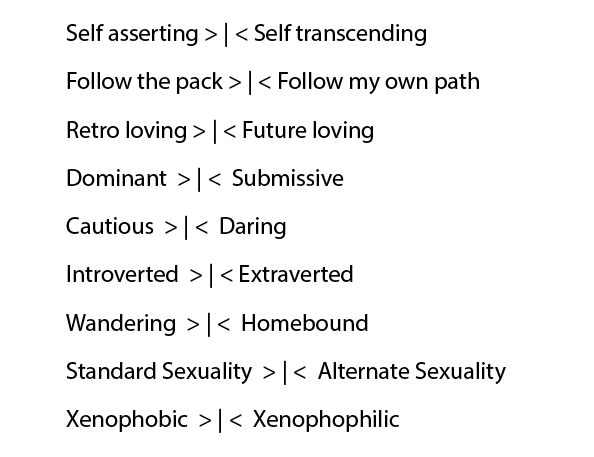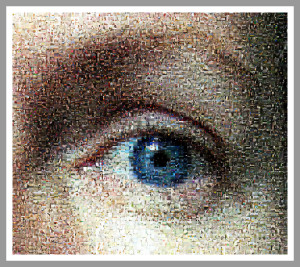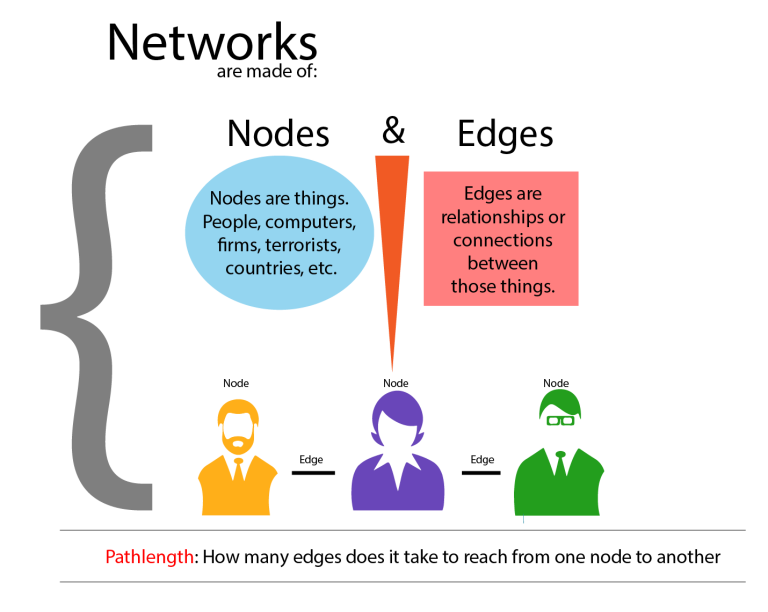Continuing my theme of the hybrid SELF that forms when people interact: The third mind. I’m not trying to create the idea of some kind of mystical entity. The third mind is simply a lens or filter for understanding ourselves.
There is no real “You”.
“Um, I’m right here.”
“Which you are you?”
“Excuse me?”
Friendship:
Every person you know and love has a bond with you like a chemical signature. You think you visit them but you don’t. You visit US. You are a different you with Tom and Petra and Janine. When you visit Janine you think you are seeing her, but you are seeing US.
You know that great way you have fun with her, cooking together and joking around? It isn’t exactly like that with anyone else. That isn’t you and it isn’t her. That’s the third mind. The US. The thing is, your friendship isn’t you and her. It’s what she brings out in you and what you bring out in her. Your friendship is the magic spot where those unique things overlap. This is really reminiscent of the Observer Effect in physics. You can’t study the thing without influencing and effecting it. There is no abstract, pure Janine. You can only know her the way she is when you are looking at her. She can only know you the way you are when she looks at you.
You get together with Janine and your mutual friend Petra. You don’t really know the way Janine is with Petra. You know how Janine is with YOU and Petra. You are standing there with Janine before Petra comes inside. You make a funny literary reference and she laughs and reminds you to keep thinking about that thing you talked about earlier. Why? Because when Petra is part of this molecule the sense of humor is different, maybe earthier, and you’d never really bring up that sort of serious thing for discussion because it would be the wrong kind of discussion. You guys LOVE Petra, you love being together. It’s wonderful, but it’s wonderful in a different way. So you tidied up business with the You and Janine molecule before the well understood transition into the 3 of you molecule.
The personality “You” was evoked in a unique way with one other person and then in another unique way only possible with that exact combination of the three of you. And if you leave, Petra and Janine have a different relationship. If you let yourself ride this idea it’s a hoot because there is no real you, there’s just what can be brought out of you by different people. And since the same is true for them there’s no real anybody anywhere. There are only the unique creations of relationships. In “The Four Loves” C.S. Lewis wrote a beautiful thought on our subject which I have to paraphrase here. Talking about the death of a friend: “If Jim dies I don’t just lose my unique friendship with Jim, I lose the way Jim used to laugh at Robert’s jokes.”
Friendship can be a lovely, lifetime thing in many cases because there is this enjoyable facet of you that you only get be in their company and they evidently have their own version of that joy. One note and another note being played at the same time are not those notes. They are a chord. And the easy, warm cruising of friendships across time is helped by its episodic nature, you don’t ALWAYS have to be that expression of yourself but you can return to it…like an old friend.
You might argue that the real you is who you are when you are alone but you are wrong, and stop being so argumentative!
Even all by yourself, the “You” experience is context-based and evoked by circumstances. It’s actually rather limited. You can’t be that warm, loving guy or the funny guy or the good listening guy. In some ways being alone is sitting with all the things you can’t be. Being in no external relationship reveals a kind of spartan, stripped-down you, but if you are alone for 10 days, I bet you spent time with 4 or 5 different versions of you.
For creative types (and introverts), there can be a special and productive relationship to being alone. A dedicated artist in any field isn’t usually alone because they have built a substantial relationship with the work. The discipline and focus centered on external results provokes, frustrates, and inspires in a way equal to any human company. But it’s still a selective filter that isn’t real in any other situation.
The principles of the third mind are laid out simply above and they don’t change with strangers or those closest to us. What changes is the impact or “side effects”.
Romantic love adds an element that only happens in its domain. Limerence. That dazzling infatuation which when reciprocated turns the third mind into a nearly visible glittering ball between the two people. This is where the third mind transforms into a different entity, almost literally an entity pulling intense emotions and hormones to the surface from the couple. It grows larger and practically seals the lovers inside. Of course, this is the human mating dance. This is the REAL honeymoon, a time of being swept up in something huge and electric and magical. When people look back on this phase, the third mind can seem like anything from a horrible deception to a lost golden age. If it does the job nature intends, a family follows.
Family:
With family relationships, we are playing with forces that help to define us. Mom and Dad are together in a tight pair bond, founded in romantic love. When baby makes three there’s a deep change in the orientation of the parents. Very much a team but a team that doesn’t have a lot of hot sex anymore and a team embarked on a shakedown cruise with a new person. Before the baby is old enough to a political player in the family there’s this period of adjustment to the altered definition of the pair bond. “We are now people who discuss what poop looked like.” This can also be a time where new facets of self come up in Mom and Dad because parenting builds a new floor onto the edifice of YOU. Your way of relating to the kid becomes a bit of new wild card. It’s natural and fine for Mom and Dad to be on somewhat different pages about parenting. But what it does here can be an alteration of the third mind in a way that adds stressors and subtly distances them. It only deepens when the child is a distinct personality, becoming triangulated and heating up any of those parenting issues. At times each feel parent will feel double teamed or manipulated and new kinks in the flow develop. Whatever the couple’s third mind started as it has morphed and tilted. Not necessarily in a terrible way, but forever. There is no going back. And something strange starts to happen here. It can feel like the power of this mind exerts such pressure that you begin to actually possess the characteristics projected onto you. As if the third begins to alter and edit you often in ways that are not pleasant. If people have a common complaint about family it’s probably this: The weird way you can’t help either becoming a certain person around them or putting all your energy into resisting it.
Children grow up with the family mind, a sort of interactive group sense of self: A growth medium made up of ourselves and a variety of subjective, overlapping reactions to us.
Marriage:
God knows there are lovely, happy, and vital marriages out there. And where they exist they probably have a rare relationship where the couple feels a great ongoing enjoyment with what gets brought out of them into the world by the other. This mutual bringing forth: “I love her and I love who I am when I’m with her.”
It’s easy to imagine the reasons things that can become stultifying and even miserable in some marriages. First, unlike friendship, this relationship has no easy come and go. It is your default and almost fulltime existence So it’s more serious from the start but also, people change. Especially as they grow up through their 20s and 30s and 40s. You could hardly help and nor should you, being different after all that. But that means that the unique signature of your personalities as they evoked each other when you married is gone. Perhaps not wholly but substantially. Even without inner change over time, the signature shifts as people reveal their more intransigent sides, as issues become wearisome and people become resigned.
But finally, there’s this: It becomes deadening when you only get to be one version of you year after year. Especially if that version of you is largely defined by a long history of ups and downs, tensions and compromises. Inside ourselves we know we are a 360-degree personality and this arrangement lets you express only a familiar, comforting, reliable constellation of all the possible YOUs for the sake of another person’s security and happiness.
It’s no wonder people struggle. There’s this tremendous investment in a situation that feels gradually less like home because you aren’t really getting to be yourself there or at least the version of you that you’d like to be. And fixing a marriage that feels very stuck is so challenging because even the medium for discussion can only be within the petrified and weary third mind.
There is no one real YOU, there are thousands.
Why you need to have one
is not much more mysterious than
why you don’t say what you think
at the birth of an ugly baby.
Or, you’ve just made love
and feel you’d rather have been
in a dark booth where your partner
was nodding, whispering yes, yes,
you’re brilliant. The secret life
begins early, is kept alive
by all that’s unpopular
in you, all that you know
a Baptist, say, or some other
accountant would object to.
It becomes what you’d most protect
if the government said you can protect
one thing, all else is ours.
When you write late at night
it’s like a small fire
in a clearing, it’s what
radiates and what can hurt
if you get too close to it.
It’s why your silence is a kind of truth.
Even when you speak to your best friend,
the one who’ll never betray you,
you always leave out one thing;
a secret life is that important.
– by Steven Dunn

“A colony of honeybees is, then, far more than an aggregation of individuals, it is a composite being that functions as an integrated whole. Indeed, one can accurately think of a honeybee colony as a single living entity, weighing as much as 5 kilograms (10 pounds) and performing all of the basic physiological processes that support life: ingesting and digesting food, maintaining nutritional balance, circulating resources, exchanging respiratory gases, regulating water content, controlling body temperature, sensing the environment, deciding how to behave, and achieving locomotion.”
There is an idea gaining credibility that just as hives behave as individuals made up of the independently moving “cells”, that primate brains are almost like hives unto themselves…vast collectives of caste system individuals handling tasks that cumulatively produce the neurological reality experienced by the individual. This can’t be described as a final proven fact, but the model holds up, right down to the notion of specific cells that are needed being produced. algorithmically to changing needs. This extends to decision-making, which is the main subject of Honeybee Democracy. The bees exercise a collective intelligence that mimics not just small-group decision-making but the cognitive deliberations of our own brains:
“We will see that the 1.5 kilograms (3 pounds) of bees in a honeybee swarm, just like the 1.5 kilograms (3 pounds) of neurons in a human brain, achieve their collective wisdom by organizing themselves in such a way that even though each individual has limited information and limited intelligence, the group as a whole makes first-rate collective.”
Like many biologists, Seeley sees a bee colony as not just a collection of individuals but as a sort of super-organism. He continues:
Earth needs a little team spirit! In a quest for unity and good sportsmanship we’ve started a team that everyone can join in anticipation of eventual extraterrestrial opposition. You know it will come and we need to be ready.
So Go Team Terra! Yup, we called dibs on naming it. We’ll have to hammer out what sport we play later, We’re torn between Australian Rules Football and Curling. Either way, it’s not the sort of issue likely to become divisive. And of course we have to keep in mind that our alien adversaries may have sports that vary in small ways from our own. So that can wait.
But we need a mascot. Both cats and dogs have been considered but to choose one and not the other would alienate almost half the human race. Not a good start. Some sort of cat/dog hybrid was considered but it turned out to look like a carnivorous monkey. That brought up the idea “Why not People?” So…The Terran …People? We quickly realized that it would be necessary to have a cute mascot pictured on the jerseys and key chains and coffee mugs and we could not agree on a cute person, or face, or sex or ethnicity or implied religion… Continue reading
The recent breakthrough in deciphering petroglyphs has yielded some surprising results. Scientists at various ancient settlement sites have learned what sorts of thoughts our early ancestors left for us, carved into stone. The messages fell into patterns that show a remarkably similar content across sites worldwide. It has led to speculation about a possible ancient culture that spread almost globally as well as conflicting theories suggesting that people are just dumb.
- Most common was “Your Mom!” generally associated with images of extremely overweight animals doing embarrassing things.
- In second place, drawings of dicks.
- Third place globally, was “I wish to have coitus with ______” (female name)
- Fourth place was a message that could generalized as “For a good time lurk in the big bushes outside cave 12”
In this post I’m bringing together some diverse psychological research. The idea I want to support is that human beings have strong and predictable reactions to power and weakness. Each of these videos alone makes an interesting (and often disturbing) point but together they show what happens to people given “the upper hand” and some of what happens to the people they hold it over. It’s important to me as a foundation for some of the next ideas I’m going to be laying out. This is difficult collection. They are worse together than alone. It feels like a damning indictment of the human race but I’m not looking to scold so much as to understand . The important thing is establishing a clear picture of our native relationship to power and privilege. I think of this post a bit like evidence before the court. I’m going to cite this post in later articles.
There are fascinating and dark things here, but many of these videos are too long for casual viewing. The exception might be the last one, “Money on the mind” which is also very interesting and much cheerier than the rest.
Stanford prison experiment
Blue eyes brown eyes
Every human blends a wide range of psychological variables. Each variable in this list is a spectrum and everyone is somewhere on each spectrum in this list. I don’t think this is some complete list, just some that I was mulling over. And they don’t follow some meaningful rule concerning their position to the left or right. I mean for example that “daring” and “submissive” are not in any sense related because they both appear on the right. There may be some overlap between some of these characteristics that could justify a connection but it’s imperfect and I’m not intending that meaning. I also don’t think that good is on one side and bad on the other.
Every trait on this list is a spectrum.

It seems human groups naturally create a spread of these traits because I can’t think of any culture outside of science fiction where there is a real uniformity of these characteristics.
The old sci-fi tradition often portrayed a trait as a species. Remember Star Trek? Vulcans, Klingons and Romulans, Ferengi? Each of these takes all the variables for a self and mashes them through a single psychological template.
Imagine how profound (and awful) the effect would be on a culture if they exclusively doubled down on the most extreme range of the traits above. In theory, you could have an entire population very unbalanced in a certain direction. But it never seems to work out that way, does it? Perhaps the whole thing is absolutely random but there could be within us a sort of community algorithm to keep a healthy range of steady but flexible groups. Some flexibility in the system would allow different tribes to investigate the effects of leaning more this way or more that way as a group. I don’t mean the tribe would look at it that way, just that cultural differences would naturally emphasize different traits and there could be an impact on survival as a result.
There are also structural, age-based ranges for a number of important psychological factors concerning the community’s ability to preserve it’s form but also change if it needs to.
- The very young imprint the culture, taking it at face value.
- The young adult/teenager range is the most progressive, the most likely to question things being this way. It’s a cultural version of questioning your own parents.
- Families, mated and settled are the meat in the sandwich. They essentially express and live the culture in a moderate conservative way. Naturally, they tend to embrace it but the cracks and stressors show up here too. In worrying about their own children they worry about all children and what world they will live in. Again, this tends toward conservatism but enough worry can turn this.
- The old of course tend to be convinced that everything is going terribly wrong and we ought to back the hell up. They are the paragons of cultural retention.
These behaviors are emergent from the developmental moment of each but across a culture the impact is factorial.
I think this is rather like the age-based division of labor in insect hives. We have a non-random, predictable political range (“tension force” if you read my other stuff on conservative/progressive). I suspect evolution is a little bottom heavy with more people in the conservative mode but always with enough wild-ass adventurous and rebellious types to keep stirring the pot.
I have a half-assed thought that neuro-atypicals such as Autism spectrum and ADHD people may figure in population dynamics as a necessary element. Autistic people famously helping to advance technology with their obsessive interests and keen observations and ADHD people (I like to think) because their restless love of novelty may contribute in its own way.
I also believe that high functioning psychopaths and narcissists have a place. Their utter lack of concern with others and cold desire to get all the goodies CAN act as an organizing mechanism creating political or religious movements or starting big businesses, etc. Someone sufficiently convinced of their right to rule over others can collect followers like a magnet collects iron filings.
- If a doctor (say, on a desert island) had no real medicine left, just some sugar pills, wouldn’t it logically be ethical for him to hide this fact from his patients and even do his best to play up the theatrical side to deliver the strongest “dosage” possible?
- Doesn’t it mean that tribal style shamanic healers were actually doing what they could for their patients? And at least to a degree succeeding?
- When drug trials get to the human testing level, do the experimenters take the effect into account? When judging results do they allow a sort of fudge factor both for the control group and the test group? Because they would both be affected. How do they “zero out” the effect?
- How to understand the impact of things like size and shape and color (and communicated expectations) on the prescriptions we use daily?
- Would it ever be medically unethical to tell someone experiencing a benefit that it was only a placebo?
- If we know it helps the effect for the pill to have some “show biz” should real prescription pills be designed also to impress? Are they already?




